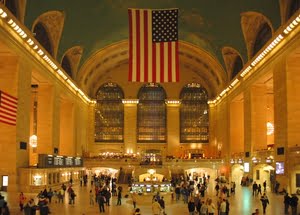Gone is the golden age of long-distance luxury travel by rail. Wealthy railroad industrialists built the stations of the nation in the cities that were critical for connecting people and business. However, highway construction and the explosion of private automobile explosion post-World War II changed all that. Are we fully utilizing these cavernous, historic spaces in prime urban locations?
Grand Central Terminal, New York City
Narrowly saved from the wrecker’s ball, New York City’s Grand Central Terminal is currently a bustling, growing space with a steady stream of tourists and travelers alike. The granddaddy of them all, Grand Central is the world’s largest train station by the number of tracks and is expanding still. Host to 21.6 million tourists a year, Grand Central is a mini-city within a city, poised to celebrate its centennial in 2013. Used as a backdrop for dozens of films and television shows, it is very much a part of the typical New Yorker’s life, especially commuters and East Side residents. Grand Central is home to chowder at the famous Oyster Bar, classic martinis at Cipriani’s, a haircut, a shave, and a polish, a daily coffee and the daily paper, a ride home, a place to meet friends under the elaborate clock. Take a tour and learn about the secrets of the station.
Union Station, Washington, D.C.
Opened in 1907 and used by 200,000 people per day at the height of World War II. Still busy, it is used by 12,500 commuters a day and is visited by 37 million people a year. Surprisingly, it claims to be the capital city’s top visitor destination, yet there are no tours of the station itself. A replica Liberty Bell and a triumphal arch with allegorical statues by famous sculptor St. Gaudens grace the entrance. The architecture encompasses Classical, Beaux-Arts, and Baroque design. See soaring ceilings of 96 feet with touches of gold leaf in the Great Hall, admire investments of expensive marble and granite throughout. The station once offered all a traveler’s needs, including restaurants, gift shops, milliners, cobblers, barber shops, a presidential suite, even a mortuary. Today, 70 retailers, dozens of tour companies, and Amtrak headquarters call this home.
Union Station, Los Angeles
On the National Register of Historic Places, Union Station opened in 1939. I was looking forward to seeing a grand space, but it’s not at all impressive compared to Grand Central. Its Spanish Colonial Revival architecture, with bell towers and a garden, looks nothing like its cousins back east. There are some charming late Art Deco touches still in place, handsome leather furniture in the Streamline Moderne style. Unremarkably, Starbucks was best choice for a layover, as the one restaurant was closed. The main ticket hall stands empty, replaced by automated ticketing. The hall is available to rent for private affairs and corporate events. The master plan doesn’t call for much change over the next decade.
Union Station, Chicago
Hailed as an outstanding achievement in 1925, the prominence of Chicago’s Union Station reflects the importance of this city as a hub. The 20,000-square-foot, five-story Great Hall is in Beaux Arts style with 18 Corinthian columns, terracotta walls, and pink Tennessee marble floors. During World War II, there were 100,000 people a day passing through on their way to 300 train departures. If you’re considering a $9,000 spend before food and drink costs, you can book it for a wedding, like the directors did in 1997 to film “My Best Friend’s Wedding.”






